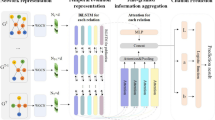Abstract
Predicting the future influential papers is a challenging issue witch has attracted many attentions. In this paper, we focused on the temporal information of citations to study the popularity prediction problem from the perspective of citation dynamics. The experimental study of the APS citation data shows that the temporal decay rate of the influence of citations is decay with paper’s age, and the decay rate is a power-law distribution. We introduced the diversity of temporal decay rate of the influence of citations to predict the future popularity of papers, and proposed a diverse temporal decay method. The result shows that this method can improve the prediction accuracy compared with other popularity-based prediction methods. More importantly, this method can detect some of the newly published papers that haven’t accumulated many citations but will quickly become popular in the future.



Similar content being viewed by others
References
Bianconi, G., & Barabási, A. L. (2001). Competition and multiscaling in evolving networks. EPL (Europhysics Letters), 54(4), 436.
Caldarelli, G., Capocci, A., De Los, R. P., et al. (2002). Scale-free networks from varying vertex intrinsic fitness. Physical Review Letters, 89(25), 258702.
Fortunato, S., Bergstrom, C. T., Börner, K., et al. (2018). Science of science. Science, 359(6379), eaao0185.
Garfield, E. (2006). The history and meaning of the journal impact factor. JAMA, 295(1), 90–93.
Gleeson, J. P., Cellai, D., Onnela, J. P., et al. (2014). A simple generative model of collective online behavior. Proceedings of the National Academy of Sciences, 111(29), 10411–10415.
Hirsch, J. E. (2005). An index to quantify an individual’s scientific research output. Proceedings of the National Academy of Sciences, 102(46), 16569–16572.
Kendall, M. G. (1938). A new measure of rank correlation. Biometrika, 30(1/2), 81–93.
Liao, H., Mariani, M. S., Medo, M., et al. (2017). Ranking in evolving complex networks. Physics Reports, 689, 1–54.
Li, S. N., Guo, Q., Yang, K., et al. (2018). Uncovering the popularity mechanisms for Facebook applications. Physica A: Statistical Mechanics and Its Applications, 494, 422–429.
Lü, L., Chen, D., Ren, X. L., et al. (2016). Vital nodes identification in complex networks. Physics Reports, 650, 1–63.
Medo, M., Cimini, G., & Gualdi, S. (2011). Temporal effects in the growth of networks. Physical Review Letters, 107(23), 238701.
Mingers, J., & Leydesdorff, L. (2015). A review of theory and practice in scientometrics. European Journal of Operational Research, 246(1), 1–19.
Newman, M. E. J. (2009). The first-mover advantage in scientific publication. EPL (Europhysics Letters), 86(6), 68001.
Newman, M. E. J. (2014). Prediction of highly cited papers. EPL (Europhysics Letters), 105(2), 28002.
Parolo, P. D. B., Pan, R. K., Ghosh, R., et al. (2015). Attention decay in science. Journal of Informetrics, 9(4), 734–745.
Price, D. S. (1976). A general theory of bibliometric and other cumulative advantage processes. Journal of the American Society for Information Science, 27(5), 292–306.
Waltman, L. (2016). A review of the literature on citation impact indicators. Journal of Informetrics, 10(2), 365–391.
Wang, D., Song, C., & Barabási, A. L. (2013). Quantifying long-term scientific impact. Science, 342(6154), 127–132.
Zeng, A., Gualdi, S., Medo, M., et al. (2013). Trend prediction in temporal bipartite networks: the case of Movielens, Netflix, and Digg. Advances in Complex Systems, 16(04n05), 1350024.
Zhou, Y., Zeng, A., & Wang, W. H. (2015). Temporal effects in trend prediction: identifying the most popular nodes in the future. PLoS ONE, 10(3), e0120735.
Acknowledgements
This work was supported in part by the National Nature Science Foundation of China under Grants 61603340, 61402413 and Grant 61340058, and in part by the National Nature Science Foundation of Zhejiang Province under Grants LY14F020019 and LZ14F020001.
Author information
Authors and Affiliations
Corresponding author
Rights and permissions
About this article
Cite this article
Zhou, Y., Cheng, H., Li, Q. et al. Diversity of temporal influence in popularity prediction of scientific publications. Scientometrics 123, 383–392 (2020). https://doi.org/10.1007/s11192-020-03354-3
Received:
Published:
Issue Date:
DOI: https://doi.org/10.1007/s11192-020-03354-3




